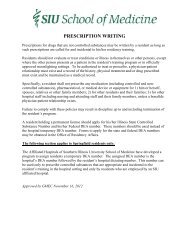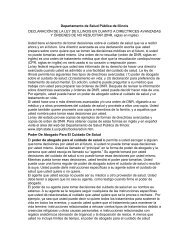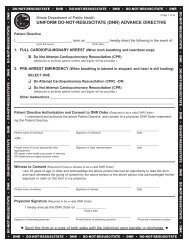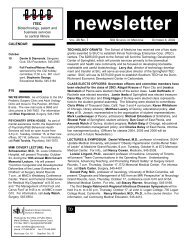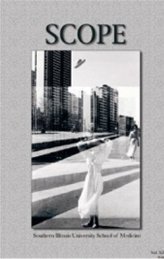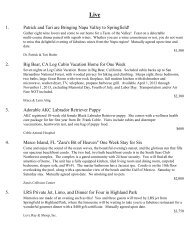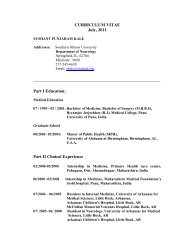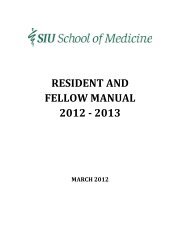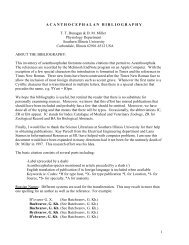Ch. 54 – Biliary System
Ch. 54 – Biliary System
Ch. 54 – Biliary System
You also want an ePaper? Increase the reach of your titles
YUMPU automatically turns print PDFs into web optimized ePapers that Google loves.
Urinary<br />
excretion<br />
(95% of biliary secretion)<br />
Synthesis<br />
(0.2<strong>–</strong>0.6 g/d)<br />
teins and hydrogen ions. Secretion of mucus glycoprotein<br />
occurs primarily from the glands of the gallbladder<br />
neck and cystic duct. The resultant mucin gel is believed<br />
to constitute an important part of the unstirred layer<br />
(diffusion-resistant barrier) that separates the gallbladder<br />
cell membrane from the luminal bile. This mucus barrier<br />
may be very important in protecting the gallbladder epithelium<br />
from the strong detergent effect of the highly<br />
concentrated bile salts found in the gallbladder. However,<br />
considerable evidence also suggests that mucin glycoproteins<br />
play a role as a pronucleating agent for cholesterol<br />
crystallization. The transport of hydrogen ions by the<br />
gallbladder epithelium leads to a decrease in gallbladder<br />
bile pH through a sodium-exchange mechanism. Acidifi -<br />
cation of bile promotes calcium solubility, thereby preventing<br />
its precipitation as calcium salts. The gallbladder’s<br />
normal acidifi cation process lowers the pH of entering<br />
hepatic bile from 7.5 to 7.8 down to 7.1 to 7.3.<br />
The gallbladder fi lls from the continuous production<br />
of bile by the liver against the force of a contracted<br />
sphincter of Oddi. As the pressure within the common<br />
bile duct exceeds that within the gallbladder lumen,<br />
hepatic bile enters the gallbladder by retrograde fl ow<br />
through the cystic duct, wherein it is rapidly concentrated.<br />
Periods of fi lling are punctuated by brief episodes<br />
of partial emptying (∼10%-15% of its volume) of concentrated<br />
gallbladder bile that are coordinated through the<br />
duodenum of phase III of the migrating myoelectric<br />
complex (MMC).<br />
Fecal excretion<br />
(0.2<strong>–</strong>0.6 g/d)<br />
<strong>Biliary</strong> secretion = pool x cycles<br />
(12<strong>–</strong>36 g/d) (~3 g) x (4<strong>–</strong>12/d)<br />
<strong>Ch</strong>apter <strong>54</strong> <strong>Biliary</strong> <strong>System</strong> 1551<br />
Figure <strong>54</strong>-5 Enterohepatic circulation. (From Arias IM, Popper H, Jakoby WB, et al: The liver: Biology and<br />
pathobiology. Philadelphia: Raven Press, 1988, p 576.)<br />
Following a meal, the gallbladder contracts in response<br />
to both a vagally mediated cephalic phase of activity and<br />
the release of CCK, the major regulator of gallbladder<br />
function. In the next 60 to 120 minutes, about 50% to<br />
70% of gallbladder bile is steadily emptied into the intestinal<br />
tract. CCK is localized to the proximal small intestine,<br />
especially the duodenal epithelial cells, where its<br />
release is stimulated by intraluminal fat, amino acids, and<br />
gastric acid and inhibited by bile. In addition to stimulating<br />
gallbladder contractions, CCK also acts to functionally<br />
inhibit the normal phasic motor activity of the sphincter<br />
of Oddi. Gallbladder refi lling then occurs gradually over<br />
the next 60 to 90 minutes.<br />
Sphincter of Oddi<br />
The sphincter of Oddi is a complex structure that is<br />
functionally independent from the duodenal musculature.<br />
It creates a high-pressure zone between the bile<br />
duct and the duodenum. The sphincter regulates the fl ow<br />
of bile and pancreatic juice into the duodenum, prevents<br />
the regurgitation of duodenal contents into the biliary<br />
tract, and also diverts bile into the gallbladder. The<br />
sphincter of Oddi also has very high-pressure phasic<br />
contractions, which play a role in preventing the regurgitation<br />
of duodenal contents into the biliary tract.<br />
Both neural and hormonal factors infl uence the sphincter<br />
of Oddi. In response to CCK, both sphincter of Oddi<br />
pressure and phasic wave activity diminish. After a meal,



